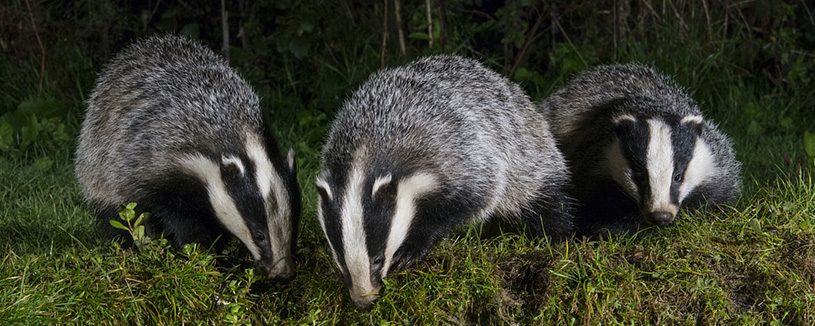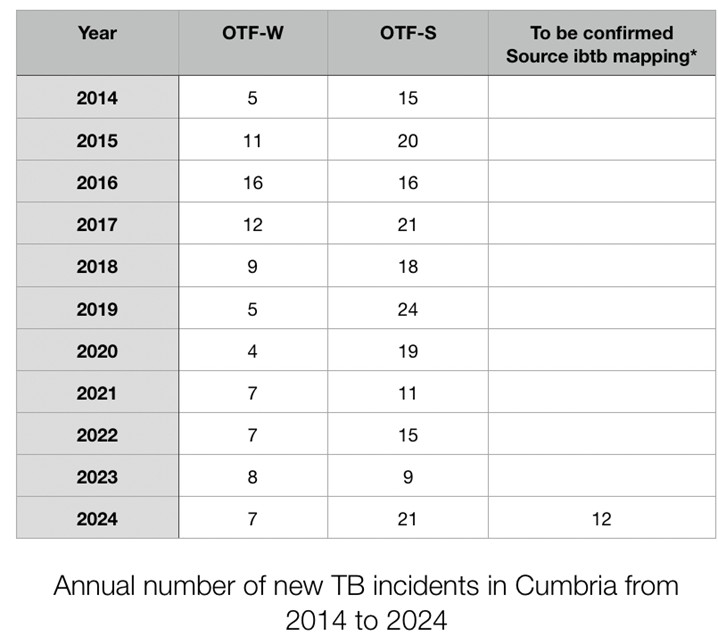A Cumbria badger bloodbath
 At the Westminster Hall Debate on the 13th October, Angela Eagle the Defra Minister of State confirmed that the badger cull would come to an end in February 2026 in all but one area. Cull Area no. 73, south of Carlisle, was initiated by Labour as a new cull zone last year (around what was called hotspot 29). It is large (183 sq km), and it can potentially run for up to five years (to 2029) with a 100% kill target, and some vaccination of any survivors. Voters have been incensed that despite Labours pledge to stop the culling that they described in their manifesto as ‘ineffective’, not only has it continued, but this new zone has been added..
At the Westminster Hall Debate on the 13th October, Angela Eagle the Defra Minister of State confirmed that the badger cull would come to an end in February 2026 in all but one area. Cull Area no. 73, south of Carlisle, was initiated by Labour as a new cull zone last year (around what was called hotspot 29). It is large (183 sq km), and it can potentially run for up to five years (to 2029) with a 100% kill target, and some vaccination of any survivors. Voters have been incensed that despite Labours pledge to stop the culling that they described in their manifesto as ‘ineffective’, not only has it continued, but this new zone has been added..
So why oh why did Labour do this, when the two previous low risk area (LRA) culls have absolutely nothing at all to show in terms of bovine TB benefit for cattle herds? (See reports & addendum updates here). Pressure came from the local branch of the NFU who said that they had been promised culling north of the initial cull area, Cumbria Area 32, that culled hundreds of badgers from 2018 (see more here). And APHA gave in, under Labour’s nose, with Natural England issuing licences to “maintain the confidence of the farming community”. Daniel Zeichner did nothing to stop it, before he was fired, after little more than a year in post.
 And Natural England (NE) who issue the culling licenses, decided to ignore an independent expert report (left) showing why LRA culling is based on circumstantial information and assumptions; available data actually suggests that the cull will bring no disease benefit at all. This independent report was disregarded by both Natural England and the Godfray review, apparently because it showed an image of a process involved in badger culling, which illustrated the content of the report: a picture of a badger in a cage trap about to be shot (see below).
And Natural England (NE) who issue the culling licenses, decided to ignore an independent expert report (left) showing why LRA culling is based on circumstantial information and assumptions; available data actually suggests that the cull will bring no disease benefit at all. This independent report was disregarded by both Natural England and the Godfray review, apparently because it showed an image of a process involved in badger culling, which illustrated the content of the report: a picture of a badger in a cage trap about to be shot (see below).
 So the only detailed technical report by non-vested scientists was discounted because it showed a picture of the methodology being employed. This decision lacks impartiality, but it is consistent with the biased and selective use of science throughout the various government justifications provided for culling. Let’s not forget, Natural England were found in breach of their statutory duty in the High Court (2018) (see more here) for trying to hide the need to protect nature reserves from the potential effects of the mass removal of badgers. More recently, Natural England, most likely at Defra’s request, cynically tried to stop Wild Justice and Badger Trust taking a legal case against culling by asking the court to require them to pay more adverse costs if they lost. The court rightly told them they had no case and to go away. Such actions are a well known government tactic to cause delay, frustrate environmental justice and run up costs.
So the only detailed technical report by non-vested scientists was discounted because it showed a picture of the methodology being employed. This decision lacks impartiality, but it is consistent with the biased and selective use of science throughout the various government justifications provided for culling. Let’s not forget, Natural England were found in breach of their statutory duty in the High Court (2018) (see more here) for trying to hide the need to protect nature reserves from the potential effects of the mass removal of badgers. More recently, Natural England, most likely at Defra’s request, cynically tried to stop Wild Justice and Badger Trust taking a legal case against culling by asking the court to require them to pay more adverse costs if they lost. The court rightly told them they had no case and to go away. Such actions are a well known government tactic to cause delay, frustrate environmental justice and run up costs.
Basically, with Low Risk Area badger killing, cattle herds in LRA so-called ‘hotspots’ are blasted with extra cattle tests and movement controls to reduce TB, so the number of breakdowns starts to go down. Then, once bTB is going down, they move in to try to kill all the badgers and then to declare culling has worked, even though breakdown incidents continue at a similar rate.
It’s a travesty. Professor Charles Godfray’s review panel recently reported to Defra, calling it a ‘proof of principle’, when there is no proof of anything. Low Risk Area culling has been a failure:
- Failure because APHA give farms within 3 km of breakdown farms a full 30 days to move (get rid of) suspect stock before they are tested and/or restricted. Guaranteed to spread disease.
- Failure because the core evidence behind badger culling policy 2013- 2025 is now redundant and riddled with statistical error.
- Failure because data shows cattle gave strain 17z from Northern Ireland to Cumbria stock and then Cumbrian badgers, but there was never any evidence of badgers spreading it other than pure government speculation.
- Failure because APHA tell Cumbrian vets to blame badgers if they are seen on a farm and not because cattle have been brought in from herds with a breakdown in the previous five years.
- Failure because in Lincolnshire Area 54 there have only been a few breakdowns, yet over 500 badgers have been shot.
- Failure because Natural England have kept making LRA cull areas bigger, so more and more badgers can be killed.
- Failure because Godfray too ignored the evidence in front of him, to back up Low Risk Area culling for Defra.
Bovine TB control in Cumbria is failing
Last year saw a record number of TB breakdowns in the County of Cumbria with a massive 39 breakdowns recorded for 2024
Area 32 – the first LRA cull in 2018 in Cumbria
Over 1000 badgers were killed between 2018 and 2021 in Area 32. During 2024 there was one B6-23 (strain 17z) breakdown (of NI origin) in northwest Cumbria. The B6-23 breakdown in 2022 just outside Area 32 has now been attributed by APHA to cattle movements. Cattle movements are being attributed where previously it was badgers getting the blame, but it is all ‘form-fiddling’. This saves face on making the Area 32 results look even more of a meaningless failure.
Area 73 – the new in 2024 cull area
It looks like the outdated and crumbling Animal and Plant Health Agency’s IT system (called SAM) is struggling. IbTB mapping is being updated less regularly and has become a poorer online reference guide for disease control. New breakdowns are being attributed to cattle movements here too, not badgers for some reason. A local shooting gang has been accused by local people of shooting cats as well as badgers and apparently wants to move to reactive culling. While behind the scenes, Labour is now apparently reported to be flagging to APHA to shut the whole thing down and not carry on for another two years as had been proposed under Daniel Zeichner’s short reign.
Area 54 – the Lincolnshire 2020-2024 cull area
Lincolnshire Area 54 Cull Area that began in 2020, and had hardly any TB breakdowns, has culled 523 badgers. Rather pathetically, they claim that the area is on track to be TB-Free in 2038 (whereas previously it had been predicted to be TB-Free by 2025); badger culling cannot be expected to contribute to this ambition in any shape or form.
|
2020 |
139 shot |
|
2021 |
161 shot |
|
2022 |
80 shot |
|
2023 |
89 shot |
|
2024 |
54 shot |
It is unclear if badger vaccination is being done in Lincolnshire Area 54, but in 2025 at least the shooting stopped. The end result? Many healthy badgers have been killed with nothing to show for it. The area still has very few herds and breakdowns from the occasional unwise purchase of stock from the west.
It’s time for the wasteful, cruel and pointless Low Risk Area culls to stop for good and to acknowledge the flawed science and evidence on which they were based.
Approaching 2,000 badgers have now been slaughtered in the Low Risk Area since 2018, due to reckless movement of high-disease risk stock, inadequate testing and negligent control rules. Labour has caried on against the public outcry. It must move to stop all badger culling in the Low Risk Area immediately and focus on the cattle measures that are known to work.





 ‘
‘